An Integrated Scheme for Forecasting and Controlling Ramps in Offshore Wind Farms Considering Wind Power Uncertainties during Extreme Storms
Abstract
:1. Introduction
- Integration of wind power ramp forecasting and control: Previous studies have mainly focused on forecasting and controlling wind power ramp events separately, resulting in the segregation of wind power ramp forecasting and control. Researchers usually adopt a self-defined ramp model to simulate wind power ramp events. Under these conditions, wind power ramp control design cannot use real ramp information for better control performance validation.
- Wind power ramp control considering uncertainties: Wind power ramp forecasts may contain uncertainties due to the intermittency of wind power. Deterministic ramp control can incur operational risks by treating wind power as deterministic variables. Therefore, wind power ramp control should consider wind power uncertainties to reduce operational risks.
- An integrated offshore wind power ramp prediction and control framework is developed to support ramp event warnings and the secure operation of the interconnected onshore main grid.
- A chance-constraint programming-based wind power ramp control strategy is developed within the integrated framework to achieve the secure integration of offshore wind power into the onshore main grid.
2. General Framework of Integrated Scheme for Forecasting and Controlling Wind Power Ramps during Extreme Storms
2.1. Wind Power Ramps during Tropical Storms
2.2. General Framework of Integrated Offshore Wind Power Ramp Control
2.2.1. Offshore Wind Power Prediction
- Step 1: Based on the collected offshore wind farm data, perform a correlation analysis and select the explanatory variables that are strongly related to wind power.
- Step 2: Using the explanatory variables, construct the datasets , , . represents the ith explanatory variable at time t. represents the wind power at time t. Divide D into the training dataset and the test dataset .
- Step 3: Input the training dataset into the MGMN to obtain the predicted wind power :where , , and represent the weight matrices of the MGMN, and and represent the bias vectors.
- Step 4: Compute the loss function:Update the weights using the gradient descent method:
- Step 5: Repeat steps 3–4 until the stop criteria are reached. Input the test dataset to check the performance of the MGMN-based prediction model.
2.2.2. Offshore Wind Power Ramp Identification
2.2.3. Offshore Wind Power Ramp Control
3. Offshore Wind Power Ramp Control Scheme during Extreme Storms
3.1. Source-Level Operational Constraints
3.1.1. Operational Constraints of ESSs
3.1.2. Operational Constraints of Thermal Units
3.1.3. Operational Constraints of Offshore Wind Farms
3.2. System-Level Operational Constraints
Objective Function of Wind Power Ramp Control
3.3. Stochastic Wind Power Ramp Control Model and the Deterministic Equivalent
4. Case Studies
4.1. Offshore Wind Power Ramp Prediction under Extreme Weather Conditions
4.2. Offshore Wind Power Ramp Control under Extreme Weather Conditions
5. Conclusions
Author Contributions
Funding
Data Availability Statement
Conflicts of Interest
References
- Cui, M.; Zhang, J.; Feng, C.; Florita, A.R.; Sun, Y.; Hodge, B.M. Characterizing and analyzing ramping events in wind power, solar power, load, and netload. Renew. Energy 2017, 111, 227–244. [Google Scholar] [CrossRef]
- Ohba, M. The impact of global warming on wind energy resources and ramp events in Japan. Atmosphere 2019, 10, 265. [Google Scholar] [CrossRef]
- Probst, O.; Minchala, L.I. Mitigation of short-term wind power ramps through forecast-based curtailment. Appl. Sci. 2021, 11, 4371. [Google Scholar] [CrossRef]
- Logothetis, S.A.; Salamalikis, V.; Nouri, B.; Remund, J.; Zarzalejo, L.F.; Xie, Y.; Wilbert, S.; Ntavelis, E.; Nou, J.; Hendrikx, N.; et al. Solar Irradiance Ramp Forecasting Based on All-Sky Imagers. Energies 2022, 15, 6191. [Google Scholar] [CrossRef]
- Abuella, M.; Chowdhury, B. Forecasting of solar power ramp events: A post-processing approach. Renew. Energy 2019, 133, 1380–1392. [Google Scholar] [CrossRef]
- Zhu, W.; Zhang, L.; Yang, M.; Wang, B. Solar power ramp event forewarning with limited historical observations. IEEE Trans. Ind. Appl. 2019, 55, 5621–5630. [Google Scholar] [CrossRef]
- Alkesaiberi, A.; Harrou, F.; Sun, Y. Efficient wind power prediction using machine learning methods: A comparative study. Energies 2022, 15, 2327. [Google Scholar] [CrossRef]
- Yuan, D.D.; Li, M.; Li, H.Y.; Lin, C.J.; Ji, B.X. Wind power prediction method: Support vector regression optimized by improved jellyfish search algorithm. Energies 2022, 15, 6404. [Google Scholar] [CrossRef]
- Wang, L.; He, Y.; Li, L.; Liu, X.; Zhao, Y. A novel approach to ultra-short-term multi-step wind power predictions based on encoder–decoder architecture in natural language processing. J. Clean. Prod. 2022, 354, 131723. [Google Scholar] [CrossRef]
- Quan, H.; Zhang, W.; Zhang, W.; Li, Z.; Zhou, T. An Interval Prediction Approach of Wind Power Based on Skip-GRU and Block-Bootstrap Techniques. IEEE Trans. Ind. Appl. 2023, 59, 4710–4719. [Google Scholar] [CrossRef]
- Ye, L.; Dai, B.; Li, Z.; Pei, M.; Zhao, Y.; Lu, P. An ensemble method for short-term wind power prediction considering error correction strategy. Appl. Energy 2022, 322, 119475. [Google Scholar] [CrossRef]
- Zhu, N.; Dai, Z.; Wang, Y.; Zhang, K. A contrastive learning-based framework for wind power forecast. Expert Syst. Appl. 2023, 230, 120619. [Google Scholar] [CrossRef]
- Li, Y.; Wang, R.; Li, Y.; Zhang, M.; Long, C. Wind power forecasting considering data privacy protection: A federated deep reinforcement learning approach. Appl. Energy 2023, 329, 120291. [Google Scholar] [CrossRef]
- Zucatelli, P.; Nascimento, E.; Santos, A.; Arce, A.; Moreira, D. An investigation on deep learning and wavelet transform to nowcast wind power and wind power ramp: A case study in Brazil and Uruguay. Energy 2021, 230, 120842. [Google Scholar] [CrossRef]
- Ouyang, T.; Zha, X.; Qin, L.; He, Y.; Tang, Z. Prediction of wind power ramp events based on residual correction. Renew. Energy 2019, 136, 781–792. [Google Scholar] [CrossRef]
- Cui, Y.; He, Y.; Xiong, X.; Chen, Z.; Li, F.; Xu, T.; Zhang, F. Algorithm for identifying wind power ramp events via novel improved dynamic swinging door. Renew. Energy 2021, 171, 542–556. [Google Scholar] [CrossRef]
- Liu, W.; Li, C.; Liu, Y.; Wu, Q. Predictive control of wind turbine for load reduction during ramping events. Int. J. Electr. Power Energy Syst. 2017, 93, 135–145. [Google Scholar] [CrossRef]
- Liu, W.; Gong, Y.; Geng, G.; Jiang, Q. Refined ramp event characterisation for wind power ramp control using energy storage system. IET Renew. Power Gener. 2019, 13, 1731–1740. [Google Scholar] [CrossRef]
- Ma, L.; Xie, L.; Ye, L.; Ye, J.; Ma, W. A wind power smoothing strategy based on two-layer model algorithm control. J. Energy Storage 2023, 60, 106617. [Google Scholar] [CrossRef]
- Abou Daher, N.; Raoofat, M.; Saad, M.; Mougharbel, I.; Asber, D.; Beltran-Galindo, J. Improve the HVAC contribution in wind power smoothing. Electr. Power Syst. Res. 2019, 171, 219–229. [Google Scholar] [CrossRef]
- Kumar, D.S.; Maharjan, S.; Srinivasan, D. Ramp-rate limiting strategies to alleviate the impact of PV power ramping on voltage fluctuations using energy storage systems. Sol. Energy 2022, 234, 377–386. [Google Scholar] [CrossRef]
- Qi, Y.; Liu, Y. Wind power ramping control using competitive game. IEEE Trans. Sustain. Energy 2016, 7, 1516–1524. [Google Scholar] [CrossRef]
- Cui, M.; Zhang, J. Estimating ramping requirements with solar-friendly flexible ramping product in multi-timescale power system operations. Appl. Energy 2018, 225, 27–41. [Google Scholar] [CrossRef]
- Sreekumar, S.; Sharma, K.C.; Bhakar, R. Multi-interval solar ramp product to enhance power system flexibility. IEEE Syst. J. 2020, 15, 170–179. [Google Scholar] [CrossRef]
- Li, B.; Feng, C.; Siebenschuh, C.; Zhang, R.; Spyrou, E.; Krishnan, V.; Hobbs, B.F.; Zhang, J. Sizing ramping reserve using probabilistic solar forecasts: A data-driven method. Appl. Energy 2022, 313, 118812. [Google Scholar] [CrossRef]
- Das, K.; Guo, F.; Nuño, E.; Cutululis, N.A. Frequency stability of power system with large share of wind power under storm conditions. J. Mod. Power Syst. Clean Energy 2020, 8, 219–228. [Google Scholar] [CrossRef]
- National Hurricane Center. Tropical Cyclone Climatology. 2019. Available online: https://www.nhc.noaa.gov/climo/?text (accessed on 8 June 2023).
- Yang, M.; Shi, C.; Liu, H. Day-ahead wind power forecasting based on the clustering of equivalent power curves. Energy 2021, 218, 119515. [Google Scholar] [CrossRef]
- Wang, Y.; Zou, R.; Liu, F.; Zhang, L.; Liu, Q. A review of wind speed and wind power forecasting with deep neural networks. Appl. Energy 2021, 304, 117766. [Google Scholar] [CrossRef]
- Kamath, C. Associating weather conditions with ramp events in wind power generation. In Proceedings of the 2011 IEEE/PES Power Systems Conference and Exposition, Phoenix, AZ, USA, 20–23 March 2011; pp. 1–8. [Google Scholar]
- Zhang, D.; Dai, Y.; Zhang, X.; Zhang, J.; Wang, Z.; Xue, L. Review and prospect of research on wind power ramp events. Power Syst. Technol. 2018, 42, 1783–1792. [Google Scholar]
- Li, Z.; Xu, Y.; Wu, L.; Zheng, X. A risk-averse adaptively stochastic optimization method for multi-energy ship operation under diverse uncertainties. IEEE Trans. Power Syst. 2020, 36, 2149–2161. [Google Scholar] [CrossRef]
- Li, Z.; Xu, Y.; Wang, P.; Xiao, G. Coordinated preparation and recovery of a post-disaster multi-energy distribution system considering thermal inertia and diverse uncertainties. Appl. Energy 2023, 336, 120736. [Google Scholar] [CrossRef]
- Li, Z.; Wu, L.; Xu, Y.; Wang, L.; Yang, N. Distributed tri-layer risk-averse stochastic game approach for energy trading among multi-energy microgrids. Appl. Energy 2023, 331, 120282. [Google Scholar] [CrossRef]
- Xiao, M.; Smaisim, G.F. Joint chance-constrained multi-objective optimal function of multi-energy microgrid containing energy storages and carbon recycling system. J. Energy Storage 2022, 55, 105842. [Google Scholar] [CrossRef]
- Yang, L.; Luo, J.; Xu, Y.; Zhang, Z.; Dong, Z. A Distributed Dual Consensus ADMM Based on Partition for DC-DOPF With Carbon Emission Trading. IEEE Trans. Ind. Inform. 2020, 16, 1858–1872. [Google Scholar] [CrossRef]
- Hodge, B.M.; Milligan, M. Wind power forecasting error distributions over multiple timescales. In Proceedings of the 2011 IEEE Power and Energy Society General Meeting, Detroit, MI, USA, 24–28 July 2011; pp. 1–8. [Google Scholar]
- Ju, C.; Wang, P.; Goel, L.; Xu, Y. A Two-Layer Energy Management System for Microgrids With Hybrid Energy Storage Considering Degradation Costs. IEEE Trans. Smart Grid 2018, 9, 6047–6057. [Google Scholar] [CrossRef]
- Dui, X.; Zhu, G.; Yao, L. Two-Stage Optimization of Battery Energy Storage Capacity to Decrease Wind Power Curtailment in Grid-Connected Wind Farms. IEEE Trans. Power Syst. 2018, 33, 3296–3305. [Google Scholar] [CrossRef]
- Bird, L.; Cochran, J.; Wang, X. Wind and Solar Energy Curtailment: Experience and Practices in the United States. Available online: https://www.osti.gov/biblio/1126842 (accessed on 8 June 2023).
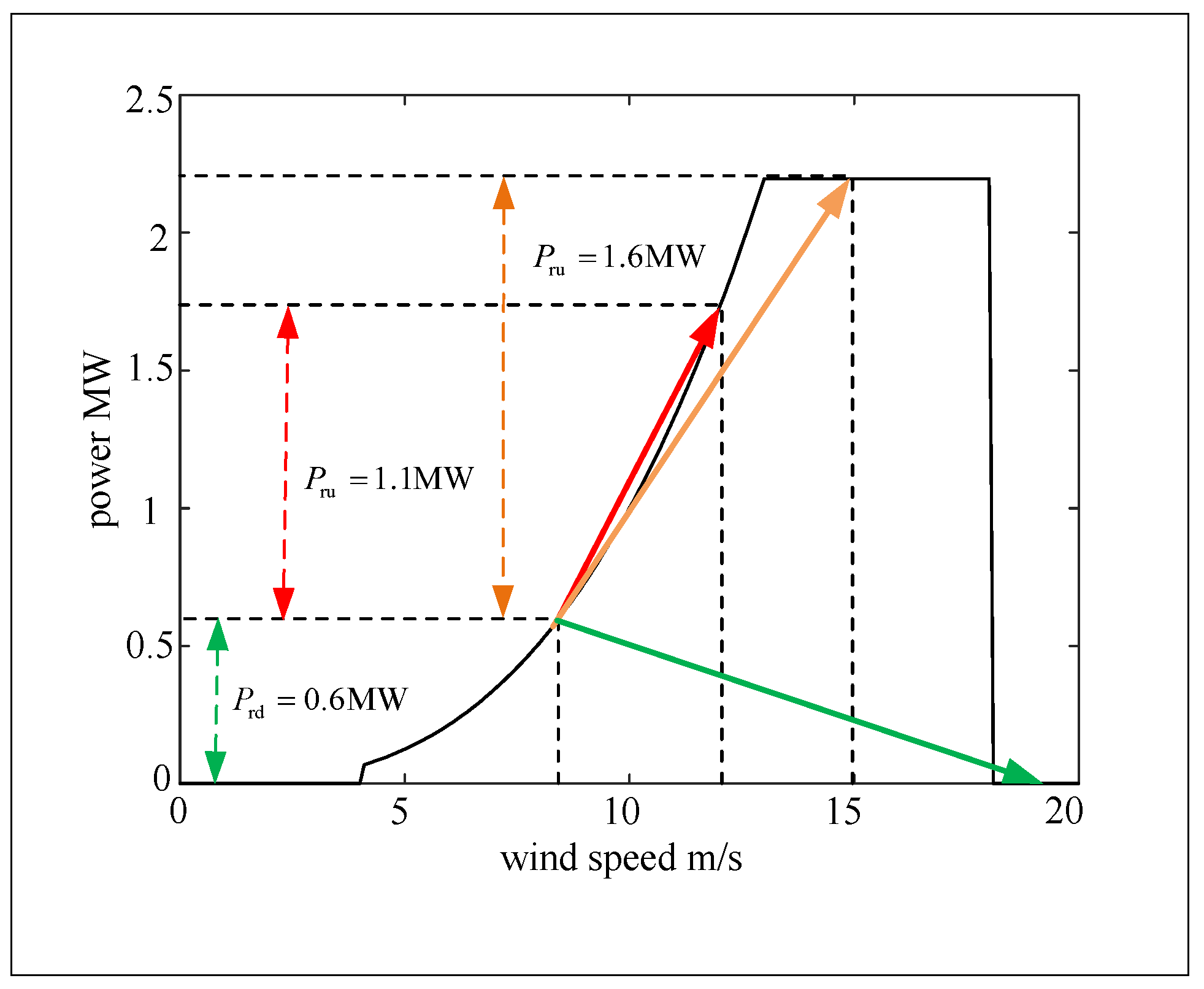
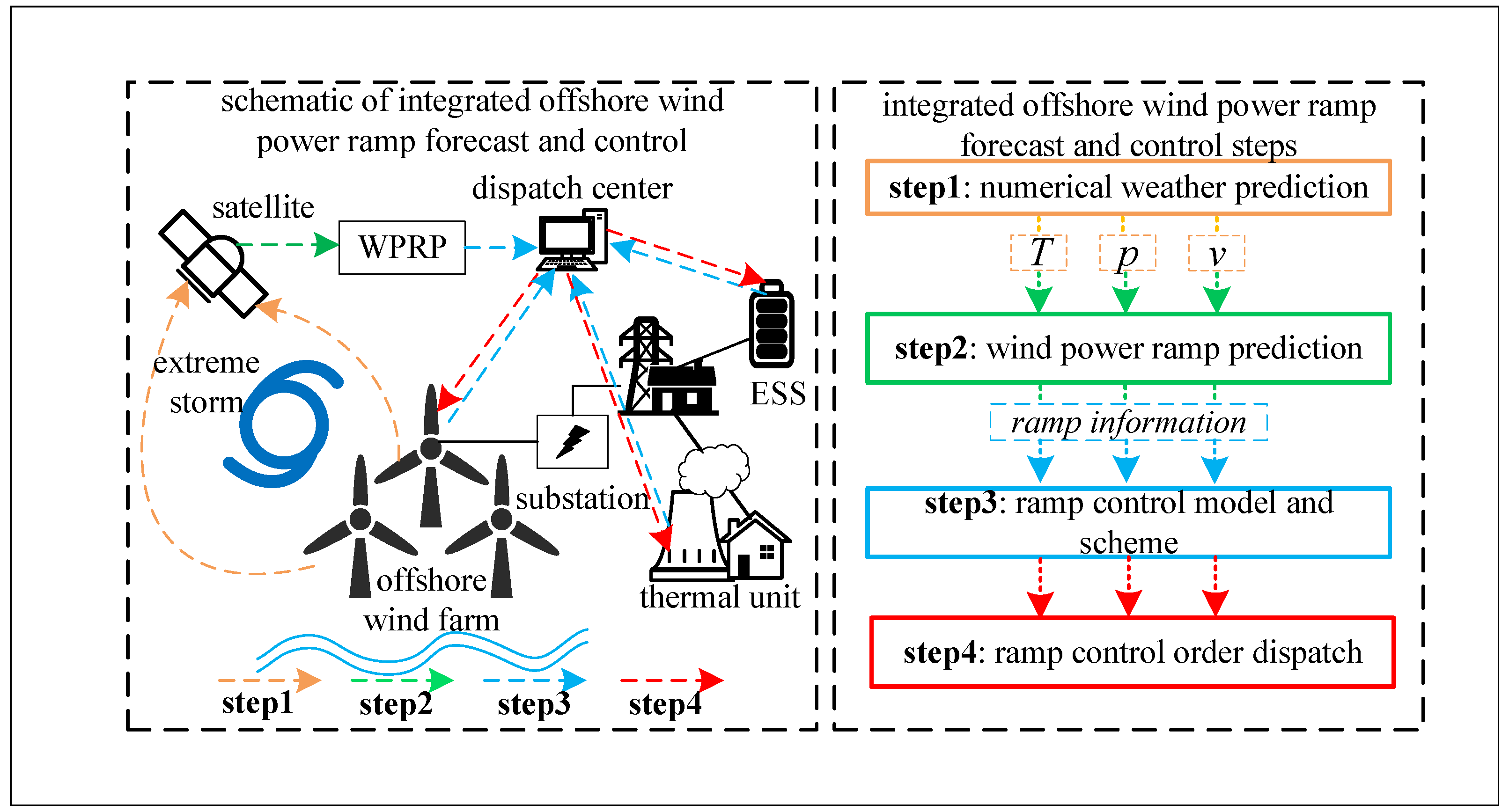


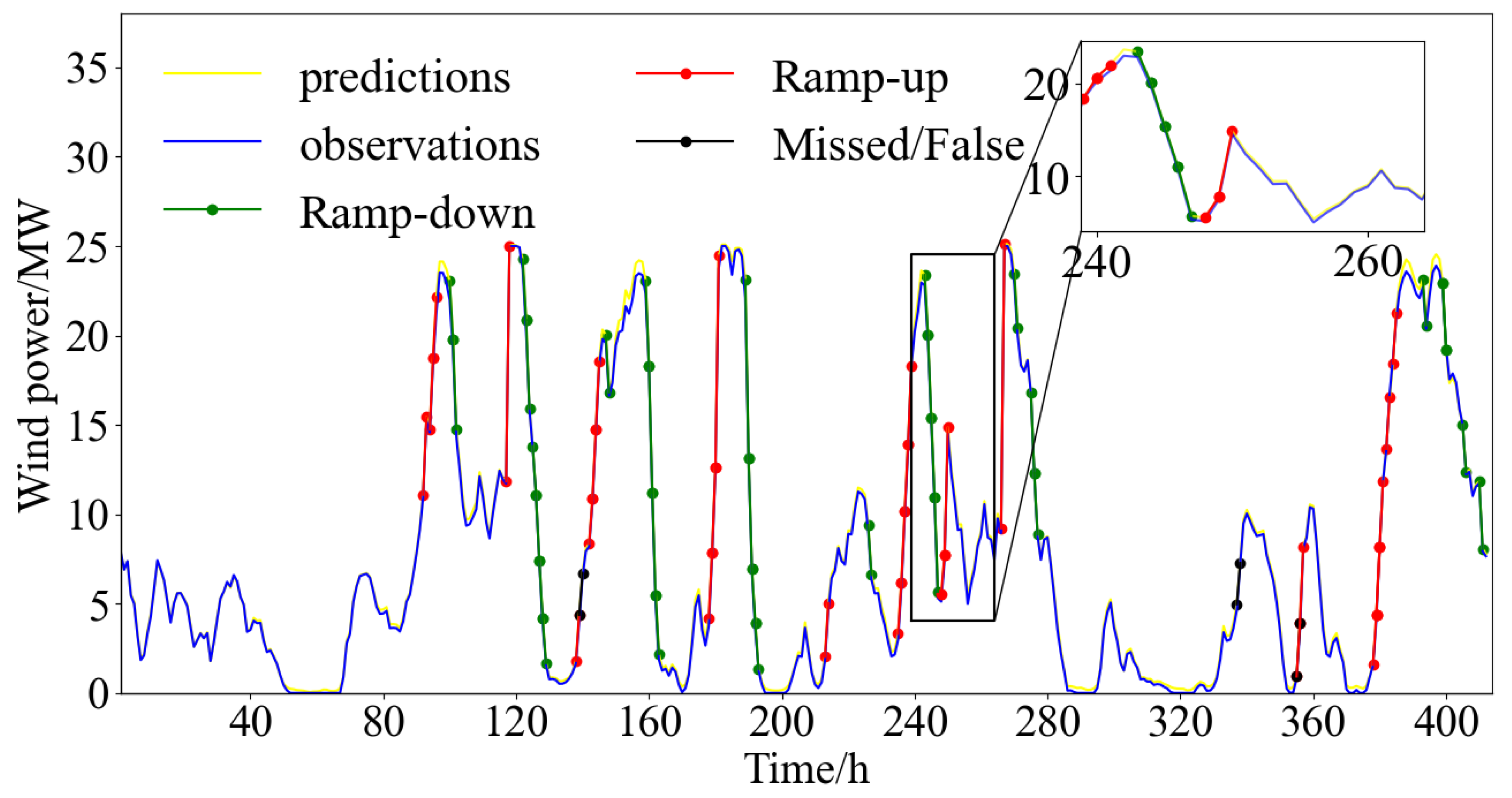
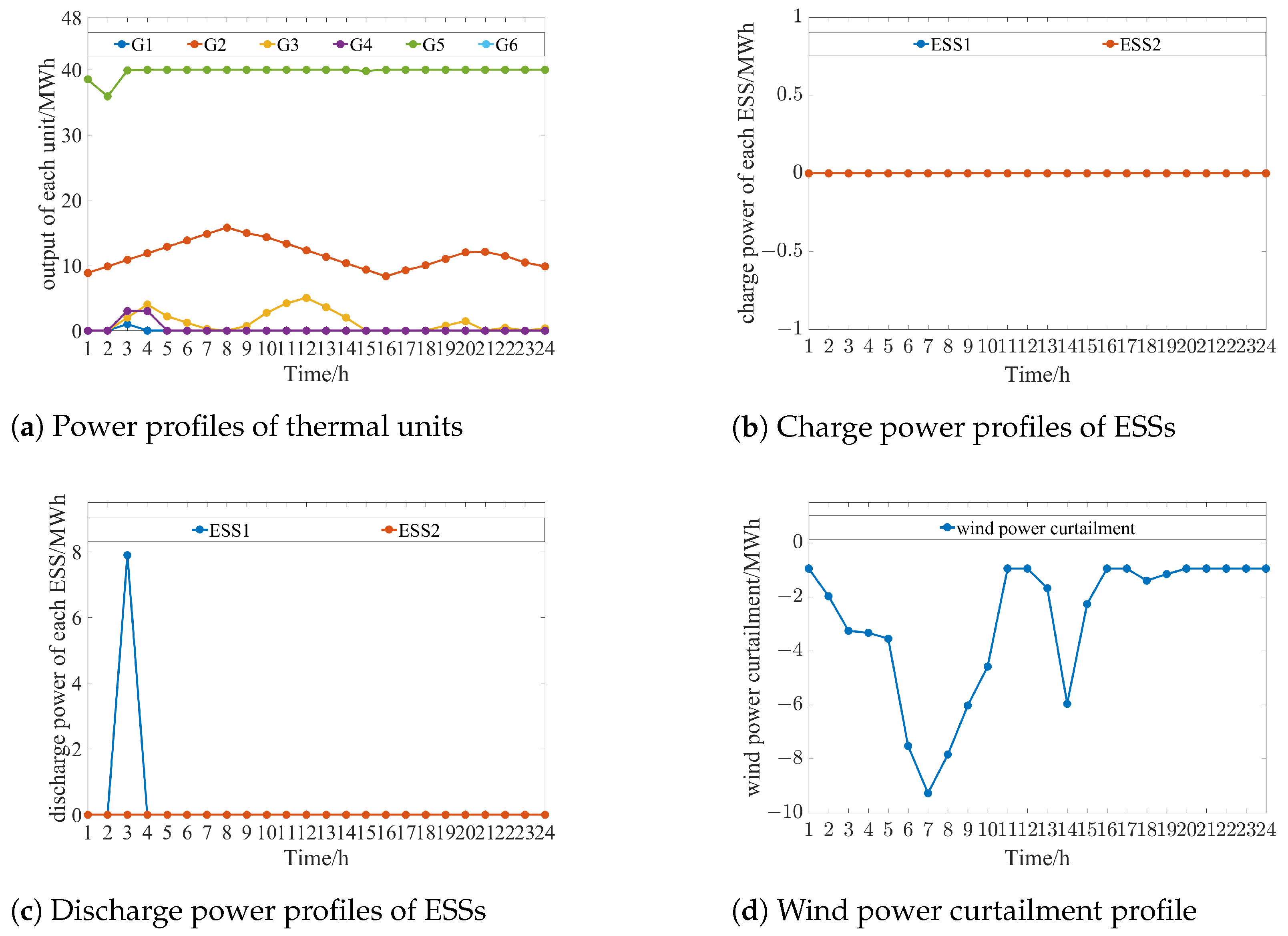

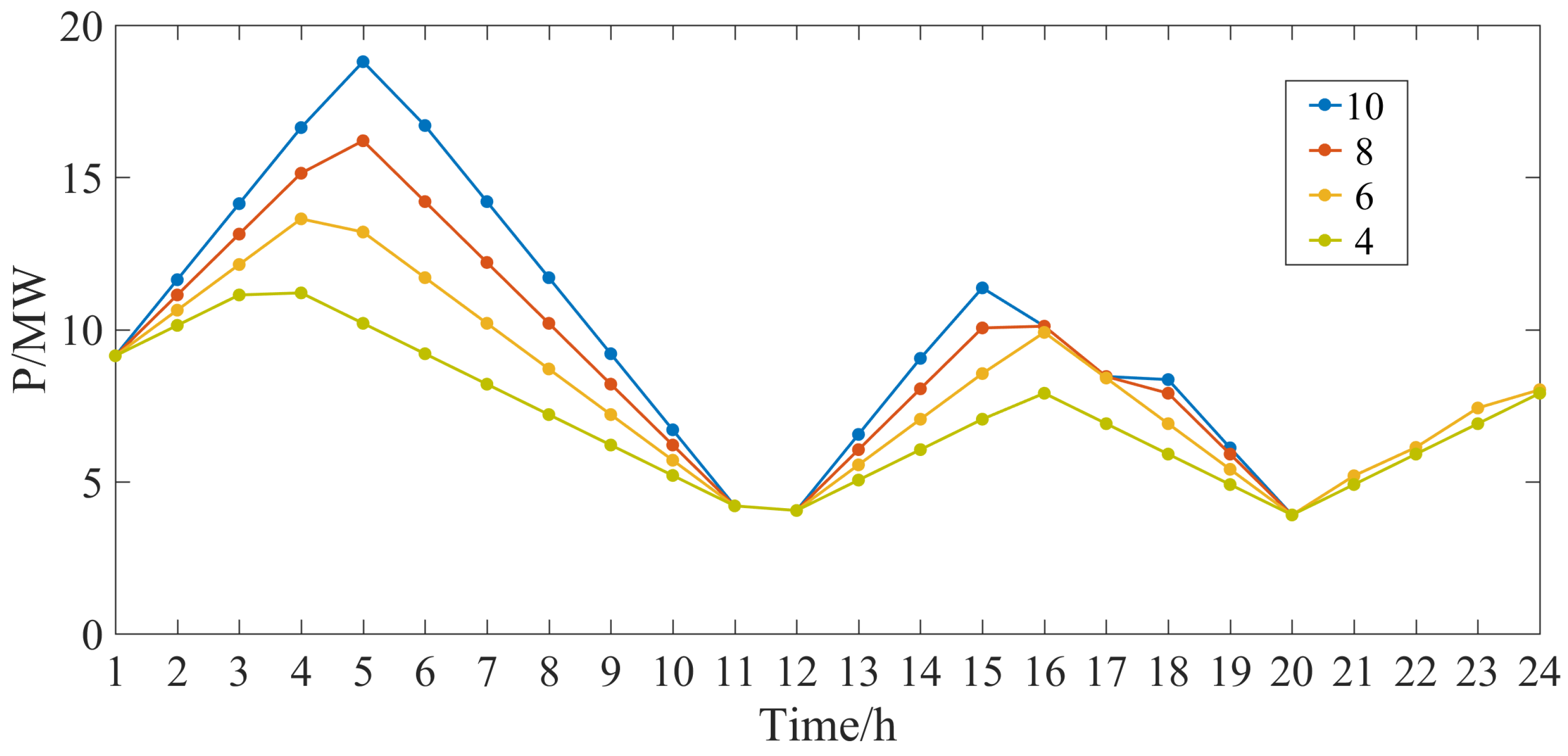

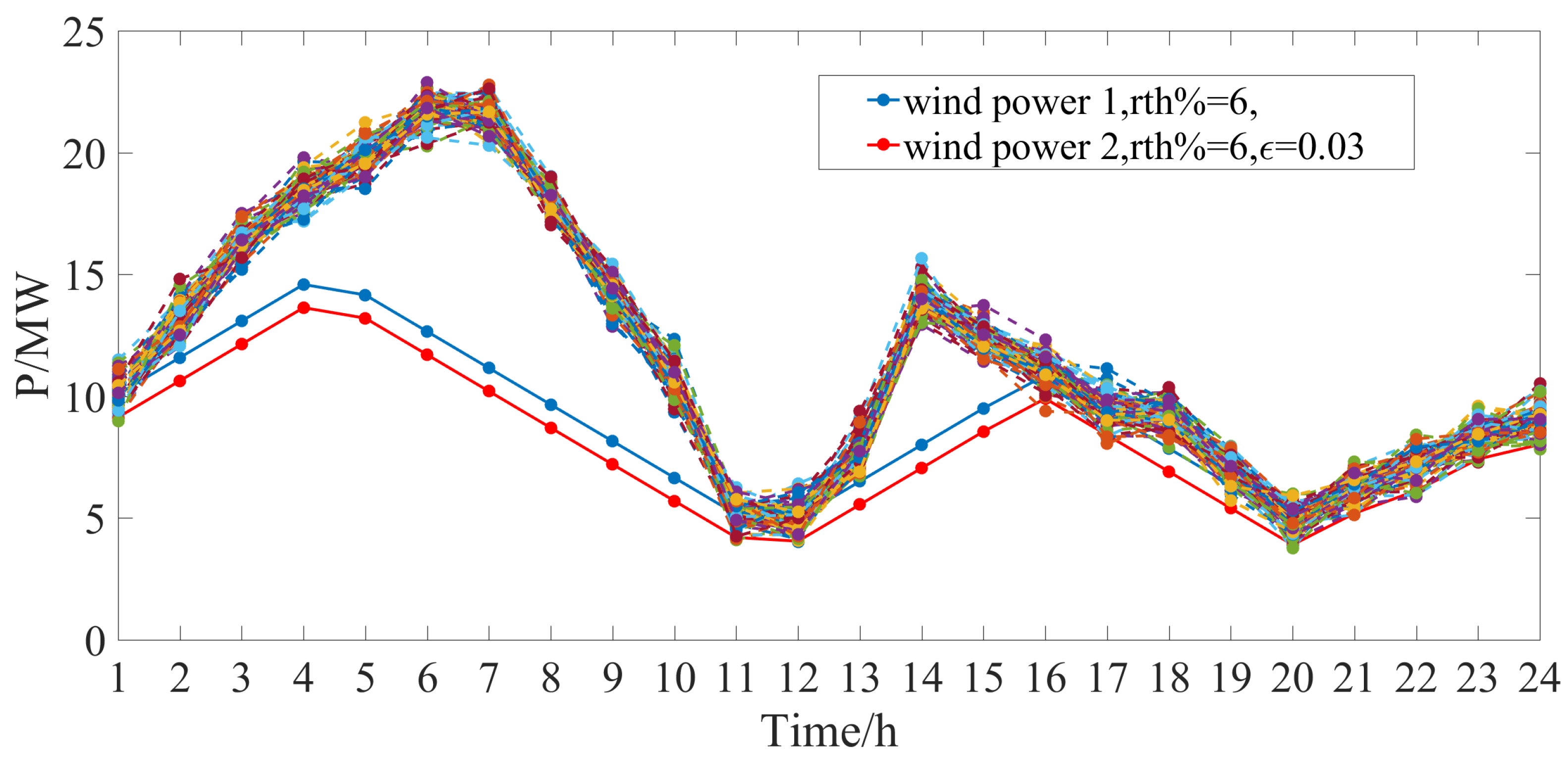
| Index | MAE | MSE | RMSE |
|---|---|---|---|
| Value | 0.052 | 0.005 | 0.073 |
| No. | |||
|---|---|---|---|
| 1 | 0.00712 | 22.26 | 370 |
| 2 | 0.00398 | 19.7 | 450 |
| 3 | 0.00211 | 16.5 | 560 |
| 4 | 0.002 | 16.6 | 625 |
| 5 | 0.00031 | 17.26 | 670 |
| 6 | 0.00048 | 16.19 | 800 |
| Thermal Unit Cost (USD) | ESS Cost (USD) | Curtailment Cost (USD) | Total Cost (USD) | |
|---|---|---|---|---|
| 10 | 103,866 | 1552 | 2652 | 10,870 |
| 8 | 104,132 | 1657 | 3481 | 109,270 |
| 6 | 104,428 | 1762 | 4394 | 110,584 |
| 4 | 104,811 | 1867 | 5572 | 112,250 |
| Thermal Unit Cost (USD) | ESS Cost (USD) | Curtailment Cost (USD) | Total Cost (USD) | |
|---|---|---|---|---|
| 0.01 | 104,516 | 1762 | 4661 | 110,939 |
| 0.03 | 104,428 | 1762 | 4394 | 110,584 |
| 0.05 | 104,381 | 1762 | 4252 | 110,395 |
| 0.07 | 104,347 | 1762 | 4151 | 110,260 |
| under the Deterministic Ramp Control Strategy | under the Proposed Ramp Control Strategy | |
|---|---|---|
| 2.207 | 0.049 | |
| 1.949 | 0.039 | |
| 1.651 | 0.029 | |
| 0.947 | 0.005 |
Disclaimer/Publisher’s Note: The statements, opinions and data contained in all publications are solely those of the individual author(s) and contributor(s) and not of MDPI and/or the editor(s). MDPI and/or the editor(s) disclaim responsibility for any injury to people or property resulting from any ideas, methods, instructions or products referred to in the content. |
© 2023 by the authors. Licensee MDPI, Basel, Switzerland. This article is an open access article distributed under the terms and conditions of the Creative Commons Attribution (CC BY) license (https://creativecommons.org/licenses/by/4.0/).
Share and Cite
Jia, Y.; Ren, B.; Li, Q.; Wang, C.; Wang, D.; Zou, X. An Integrated Scheme for Forecasting and Controlling Ramps in Offshore Wind Farms Considering Wind Power Uncertainties during Extreme Storms. Electronics 2023, 12, 4443. https://doi.org/10.3390/electronics12214443
Jia Y, Ren B, Li Q, Wang C, Wang D, Zou X. An Integrated Scheme for Forecasting and Controlling Ramps in Offshore Wind Farms Considering Wind Power Uncertainties during Extreme Storms. Electronics. 2023; 12(21):4443. https://doi.org/10.3390/electronics12214443
Chicago/Turabian StyleJia, Yongyong, Bixing Ren, Qiang Li, Chenggen Wang, Dajiang Wang, and Xiaoming Zou. 2023. "An Integrated Scheme for Forecasting and Controlling Ramps in Offshore Wind Farms Considering Wind Power Uncertainties during Extreme Storms" Electronics 12, no. 21: 4443. https://doi.org/10.3390/electronics12214443





